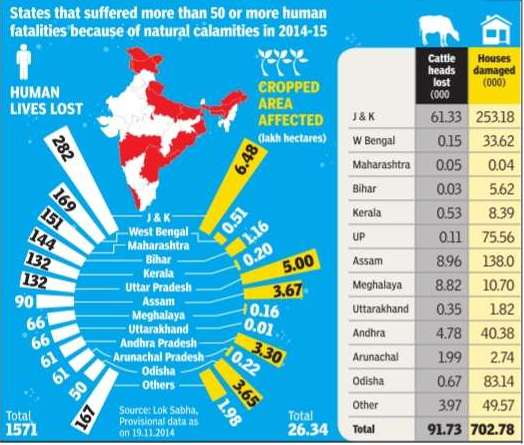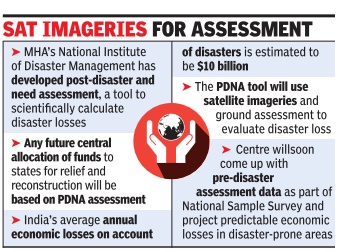Natural disasters, calamities: India
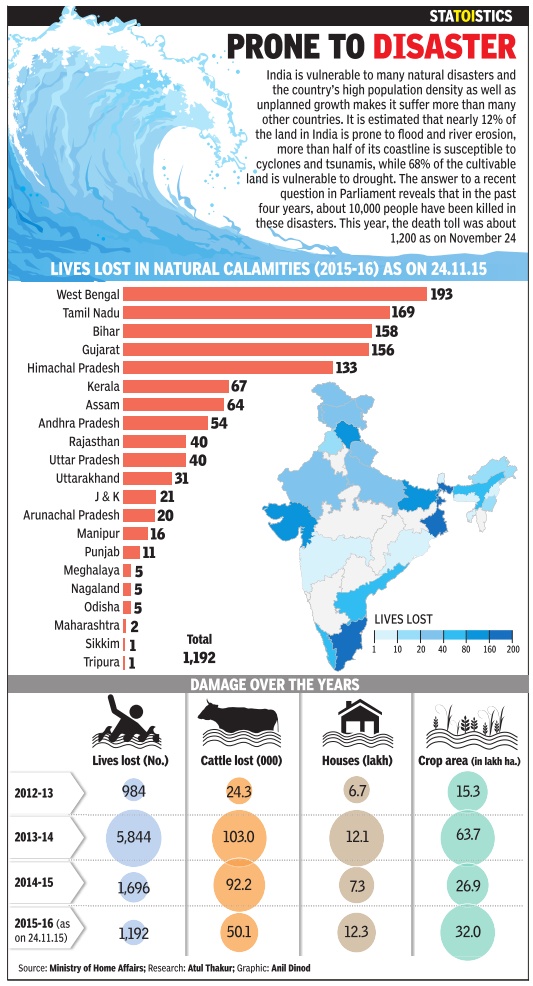
This is a collection of articles archived for the excellence of their content. |
Contents |
Chronology of disasters
1995-2015
The Times of India, Nov 25 2015
`India 3rd worst affected by natural disasters in 20 yrs'
India ranks third, after the US and China, among the five countries hit the most by natural disasters over the last 20 years, a report released by the United Nations office on disaster risk reduction has said. The Philippines and Indonesia round up the top five. `The Human Cost of Weather Related Disasters', released on Monday by the UN Office for Disaster Risk Reduction (UNISDR), showed that over the last two decades, 90% of major disasters were caused by 6,457 recorded floods, storms, heat waves, droughts and other weatherrelated events.
“Since the first climate change conference (COP1) in 1995, 606,000 lives have been lost and 4.1 billion people have been injured, left homeless or in need of emergency assistance as a result of weather-related disasters,“ the report said.
The UNISDR observed data gaps on the extent of economic losses from weatherrelated disasters as they are much higher than the recorded figure of $1.9 trillion.“Only 35% of records include information about economic losses,“ it said, and estimated that the true figure on disaster losses, including earthquakes and tsunamis, was between $250 billion and $300 billion annually .
Releasing the report, UNISDR head Margareta Wahlstrom said, “In the long term, an agreement in Paris at COP21 on reducing greenhouse gas emissions will be a significant contribution to reducing damage and loss from disasters which are partly driven by a warming globe and rising sea levels.“ For now, she said, there was a need to reduce existing levels of risk and avoid creating new risks.
2014
December 16, 2014
India witnesses huge loss of human life and property because of natural calamities. Apart from the floods that annually hit states of Bihar, West Bengal and Assam and the cyclones that hit the coastal states, 2014 also saw flooding in J&K and a massive landslide in Maharashtra.As on November 19, 2014, natural calamities resulted in the loss of over 1,500 lives across the country. More than 7 lakh houses were damaged and about one lakh heads of cattle were lost.
Lightning strikes: India
2014: Deaths caused by lightning
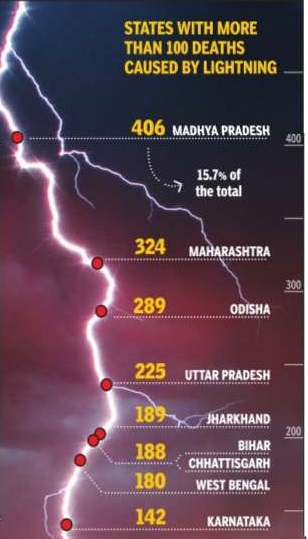
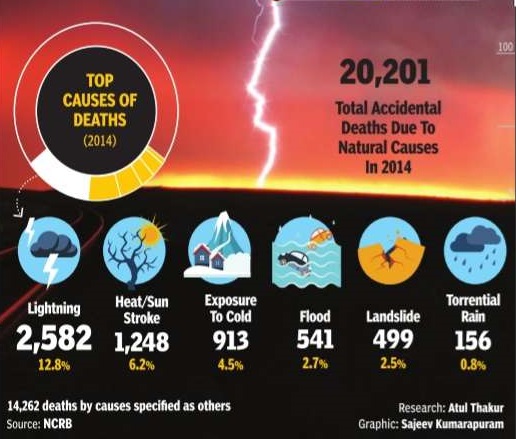
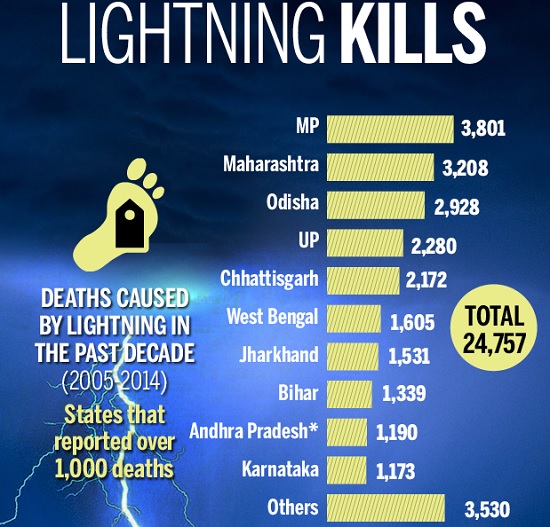
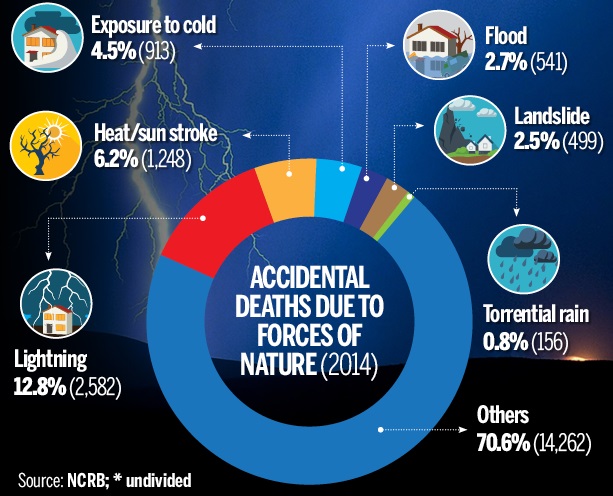
The Times of India, Sep 08 2015
In 2014, more than 20,000 people were killed by accidents caused by forces of nature.Among the known reasons of these deaths, the largest chunk were due to lightning, which alone killed more than 2,500 people. It was followed by heat sun stroke, exposure to cold and flood, each causing more than 500 deaths. A state-wise comparison of lightning deaths shows that the highest number of causalities was reported in Madhya Pradesh, where over 400 people lost their lives.Andhra Pradesh, where 19 people got killed by multiple lightning strikes on Sunday, witnessed 69 deaths in 2014.
Loss due to disasters
2016: Govt develops scientific tool to measure loss
Country Suffers $10bn Economic Damages Per Yr
The government has developed a scientific tool based on a UN model which will use satellite imagery and on-ground assessments to measure direct and indirect damages besides the `opportunity cost' lost due to disasters. This will help the Centre make a more accurate and scientific assessment of relief and reconstruction packages for disaster-hit regions, and not be dependent on the arbitrary claims made by states.
India's estimated economic losses are pegged at around $10 billion annually on account of disasters -almost equal to what the country spends on education and twice the amount it spends on healthcare every year.Globally , climate change resulted in economic losses of around $300 billion annually , according to the UN Office for Disaster Risk Reduction's (UNISDR) global assessment report-2015.
The scientific tool, called the Post Disaster Need Assessment (PDNA), has been developed by the National Institute of Disaster Management (NIDM), a part of the home ministry . It is ready for trials and a pilot will run in a calamityhit region. The tool has been designed to meet Indian conditions, though modelled on the lines of a similar tool used by the UNISDR for Latin American countries. The UNISDR tool was developed by the Economic Commission for Latin America and the Caribbean and is known as ECLAC tool for disaster risk reduction and loss assessments.
The government is also likely to engage the ministry of statistics and programme implementation to collect and publish pre-disaster as sessment data as part of the national sample survey and project predictable economic losses in disaster prone areas. This is intended to nudge states to invest more in disaster resilient infrastructure and implement disaster risk reduction policies.
“The PDNA tool will estimate cost of reconstruction, rehabilitation and measures required for disaster risk reduction (DRR) in addition to the opportunity cost,“ said Santosh Kumar, executive director of NIDM. A first-of-itskind tool, it will count opportunity cost, or the economic loss caused by interruption of services due to disasters as part of the total loss due to disasters. So far, compensation packages are estimated based on property damaged and lives lost.
The NIDM has prepared a manual for implementation of the PDNA tool and has put in place a module for training of people engaged in DRR activities. A home ministry funded project, the initiative is designed for India's long-term disaster recovery measures that would help it prioritise investment in social and infrastructure sector.
In India, the first scientific calculation of economic losses and reconstruction work, based on the ECLAC tool, was undertaken in Gujarat after the Bhuj earthquake of 2001 which killed around 20,000 people and destroyed at least 4 lakh houses. The then Gujarat government, headed by then chief minister Narendra Modi, had used the tool to assess economic losses and designed a new model of development based on resilient buildings and public infrastructure.
